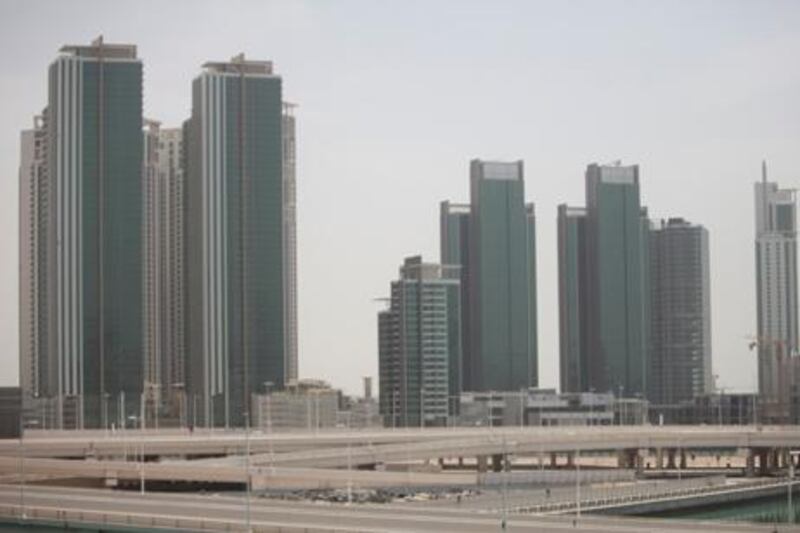Abu Dhabi house prices in investment areas where expats from outside the GCC can purchase property rose 5 per cent in the three months to June.
The rise follows an 8 per cent increase in prime house prices recorded during the first quarter of the year - the first price increase since the global financial downturn, according to the property broker Jones Lang LaSalle.
The broker reported that average asking prices in investment areas increased during the second quarter of the year to about Dh11,500 per square metre, up from about Dh11,000 per sq metre in the first quarter. However, they remain a third lower than the Dh17,222 a sq metre asking price reported at the end of 2009 when the market crashed. Average asking prices for apartments stood at Dh130,500 per sq metre, while for villas the price was Dh10,000 per sq metre.
Jones Lang LaSalle said the increases were restricted to the newly built master planned areas in the city, while house prices in the rest of the capital continued to fall because of oversupply.
It attributed the increase to longer term Abu Dhabi residents choosing to buy rather than rent, as the market begins to recover and job security returns, and to regional investors from countries affected by the Arab Spring investing in the UAE as a safe haven.
The Abu Dhabi property market was hit hard by the global financial downturn, which slashed prices and left many new schemes in the capital stalled as investors disappeared and the money ran out.
Unlike neighbouring Dubai, where house prices have been increasing for more than a year and are now rising by as much as 20 per cent per annum, there had been little sign of market recovery in the capital until this year.
"This is certainly positive news for the market, indicating the first signs of recovery and a maturing market," said David Dudley, the regional director and head of Abu Dhabi office at Jones Lang LaSalle.
"While it is encouraging to see the market moving upwards again, it is important to note that these improvements do not represent a market-wide recovery, but relate to selected high-quality developments - with performance continuing to diverge between high-grade and low-grade product."
Developers completed almost 2,300 units during the three months. New homes included the AD One Tower at Capital Centre, Eastern Mangroves Promenade Apartments, Saadiyat Beach villas and apartments, Hydra Village (Phase 1), Al Wifak Tower and Tala Tower on Reem Island and the Rosewood Residences on Al Maryah Island.
Rents in Abu Dhabi's investment areas remained flat over the past three months after increasing 8 per cent during the first three months of the year - something Jones Lang LaSalle said could be a result of government regulations to reduce the level of commuting from Dubai.
According to Jones Lang LaSalle, asking prices for prime rents remained at about Dh130,000 for prime two-bedroom apartments in the city because of growing demand and a relatively restricted supply of high-end properties.
The price remains 44 per cent below the 2008 market peak, when restricted supply meant that annual rents in prime two-bedroom apartments in the city shot up to Dh231,000 a year.
Since then they fell steadily up until the end of last year. Rents for shops also increased in Abu Dhabi for the first time since the global financial crisis as some shopping centres, including Marina Mall, increased their asking rents for some stores.
Jones Lang reported that average retail rents in shopping centres increased to Dh2,887 per sq metre in the second quarter of the year from Dh2,750 per sq metre in March.
However, it added that the increase was because of an increase in premium rents and did not signal a market-wide recovery.
Despite 49,000 sq metres of new prime office space being completed during the second quarter of the year, Jones Lang reported that prime office rents in the city have started to stabilise, remaining at the same level of Dh1,540 per sq metre for the past year. The rents remain a third of their 2008 high, when they stood at Dh3,800 per sq metre.
An increase in the number of hotels in the city meant that room rates in Abu Dhabi continued to fall. According to the report, rates fell 2 per cent over the three months to a per night level of about Dh600. However, a strategy of heavily discounted rates led to occupancy levels increasing by 8 per cent during the first five months of the year, and they now stand at an average of 70 per cent.
For the hospitality sector, the positive effect of increased visitor arrivals has been offset by the significant recent increases in hotel supply. While occupancy levels increased by 8 per cent during the first five months of this year, average daily rates have continued to remain under pressure, declining by 2 per cent. Owing to the positive growth in occupancies, revenue per available room levels in the year to May have experienced an increase of nearly 11 per cent compared with the same period last year.
"Over recent years the Government has made major moves to consolidate supply and re-prioritise its spending initiatives ahead of the next upswing," Mr Dudley added. "The medium-term prospects for Abu Dhabi are therefore very strong: the Government remains committed to investing its substantial revenue surpluses into economic development and major city building initiatives which will continue to drive employment growth and real estate demand."





